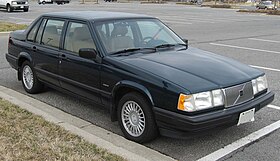Volvo 900 Series
| Volvo 900 | |
|---|---|
 |
|
| Overview | |
| Manufacturer | Volvo Cars |
| Production |
|
| Body and chassis | |
| Class |
Mid-size luxury / Executive car (E) Full-size car (S90 Royal) |
| Layout | FR layout |
| Chronology | |
| Predecessor | Volvo 700 Series |
| Successor | Volvo S80 |
| Volvo 940 | |
|---|---|
 |
|
| Overview | |
| Manufacturer | Volvo Cars |
| Production | 1990–1998 |
| Assembly | |
| Body and chassis | |
| Body style | |
| Layout | FR layout |
| Powertrain | |
| Engine |
|
| Transmission | |
| Dimensions | |
| Wheelbase | 2,771 mm (109.1 in) |
| Length |
|
| Width | 1,760 mm (69.3 in) |
| Height |
|
| Curb weight |
|
| Volvo 960 | |
|---|---|
 |
|
| Overview | |
| Manufacturer | Volvo Cars |
| Also called |
|
| Production | 1990–1998 |
| Assembly |
|
| Body and chassis | |
| Body style | |
| Layout | FR layout |
| Powertrain | |
| Engine | |
| Transmission | |
| Dimensions | |
| Wheelbase |
|
| Length |
|
| Width |
|
| Height |
|
| Curb weight |
|
The Volvo 900 Series is a range of executive cars produced by the Swedish manufacturer Volvo Cars from 1990 to 1998. The 900 Series was introduced in 1990 to replace the 700 Series from which it derived. Prior to the end of its production, the 960 was renamed as the Volvo S90 (saloon) and Volvo V90 (estate), and the 940 was renamed 940 Classic, becoming the last rear-wheel-drive cars from Volvo.
Visible differences between the 700 and the 900 Series included redesigned rear styling of the saloon models (late 700 estates and early 900 estates are visually identical.) The 960 was introduced in 1991 along with a new family of modular engines, and then was substantially revised for the 1995 model year, improving the handling. The range was first augmented and finally supplanted by the Volvo 850 in 1993, with the last of the 900s being sold in 1998. Some 900 Series were built as chassis for ambulances and hearses after the main production run had been completed.
The Volvo 940 is among the last in the long-running line of large rear-wheel drive cars from Volvo.
Introduced in September 1990, the 940 was essentially a cosmetic reskin of the 740. All drivetrains, and most options available in the 940 had been available in the 740, with the exception of the 780 Coupé. The 940 was more closely related to the 740 than the 760, sharing the same dashboard, drivetrain choices, and sheet metal from the A-pillar forward. In contrast, the 960 was an evolution of the 760. The 760 / 960 front sheet metal, independent rear suspension, dashboard, and other interior features were all exclusive to the two upscale models. The estate, introduced in May 1991, was even harder to tell apart from its 745 predecessor.
The engines remained largely the same as for the 740, with 2-litre and 2.3-litre four cylinder gasoline engines, either naturally aspirated or turbocharged, as well as the familiar 2.4-litre Volkswagen six-cylinder diesel and turbodiesels being fitted. There were also sixteen valve versions of the gasoline engines, with a turbocharged version of the 2.0 16V available in some markets with tight tax limits, such as Italy, Belgium, and Portugal. An interesting version added somewhat later was a low-pressure turbocharged version of the B230 – maximum power was only up slightly, from 131 to 135 PS (96 to 99 kW), but torque increased throughout the range and the car suffered from virtually no turbo lag because of the small size of the charger. The 155 PS (114 kW) turbocharged 2.0 was first presented in February 1991, originally intended for Italy and other such markets it was later also installed in the British market 940 SE.
...
Wikipedia
